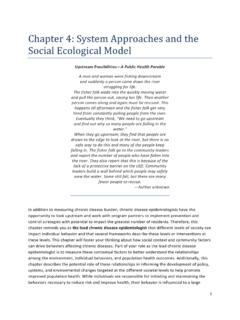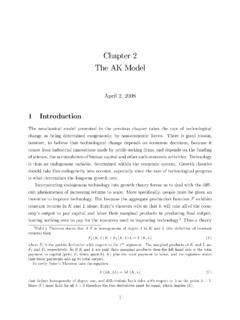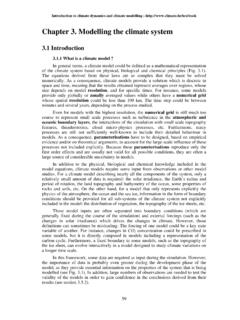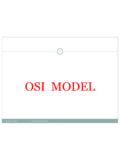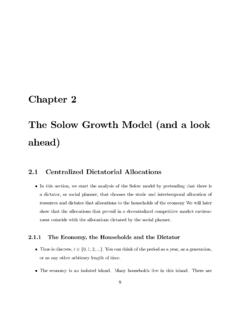Model Chapter
Found 10 free book(s)The Extended Entity Chapter 5 Relationship Model
media.lanecc.eduChapter 5 Objectives: to learn about –the extended entity relationship (E-ER) model –How entity clusters are used to represent multiple entities and relationships –The characteristics of good primary keys and how to select them –using flexible solutions for special data modeling cases CS275 Fall 20101 The Extended Entity Relationship Model
Chapter 4: System Approaches and the Social Ecological Model
cdn.ymaws.comchapter reminds you as the lead chronic disease epidemiologist that different levels of society can impact individual behavior and that several frameworks describe these levels or interventions at these levels. This chapter will foster your thinking about how social context and community factors can drive behaviors affecting chronic diseases.
Lecture 9: Panel Data Model (Chapter 14, Wooldridge …
www.fsb.miamioh.eduLecture 9: Panel Data Model (Chapter 14, Wooldridge Textbook) 2 Panel Data Panel data is obtained by observing the same person, firm, county, etc over several periods. Unlike the pooled cross sections, the observations for the same cross section unit (panel, entity, cluster) in general are dependent. Thus cluster-robust statistics that account for
Chapter 2 The AK Model - Brown University
www.brown.eduAccordingly we devote this chapter to developing the AK model and to summarizing the empirical debate that took place in the 1990s between its proponents and proponents of the neoclassical model of Solow and Swan. 1.1 The Harrod-Domar model An early precursor of the AK model was the Harrod-Domar model,2 which assumes that the
Chapter 3. Modelling the climate system - Gogs
www.climate.beChapter 3. Modelling the climate system . 3.1 Introduction . 3.1.1 What is a climate model ? In general terms, a climate model could be defined as a mathematical representation of the climate system based on physical, biological and chemical principles (Fig. 3.1). The equations derived from these laws are so complex that they must be solved ...
Chapter 3 OSI Model - EazyNotes
www.eazynotes.comPrinciples on which OSI model was designed: A layer should be created where different level of abstraction is needed. Each layer should perform a well defined function. The function of each layer should be chosen according to the internationally standardized protocols. The number of layers should be large enough that distinct functions should not be put in the same layer and …
Chapter 2 The Solow Growth Model (and a look ahead)
web.mit.edumodel, the state is simply kt.When we introduce productivity shocks, the state is (kt,At).When we introduce multiple types of capital, the state is the vector of capital stocks. And with incomplete markets, the state is the whole distribution of wealth in …
Chapter 4 Logical Database Design and the Relational Model
www.csc.villanova.edu• Relational model is more concrete, lower level – Usually many more tables than entities – Harder to understand by non-technical people – Directly implementable 24 Six Cases of Transforming E-R Diagrams into Relations 1. Map Regular Entities 2. Map Binary Relationships 3. Map Weak Entities 4. Map Associative Entities 5.
Chapter 5 Resources and Trade: The Heckscher-Ohlin Model
people.tamu.eduTwo Factor Heckscher-Ohlin Model 1. Two countries: home and foreign. 2. Two goods: cloth and food. 3. Two factors of production: labor and capital. 4. Mix of labor and capital used varies across goods. 5. The supply of labor and capital in each country is constant and varies across countries. 6. Both labor and capital can move across sectors,
CHAPTER 6 THERMAL DESIGN CONSIDERATIONS - NXP
www.nxp.comThermal design considerations Chapter 6 Lead Frame Design The design of a lead frame is another significant contributing factor to thermal resistance. The most important design aspect is the IC attach-pad size and tie bar design. However, the lead frame designer is often faced with fixed parameters such as die size and wire

